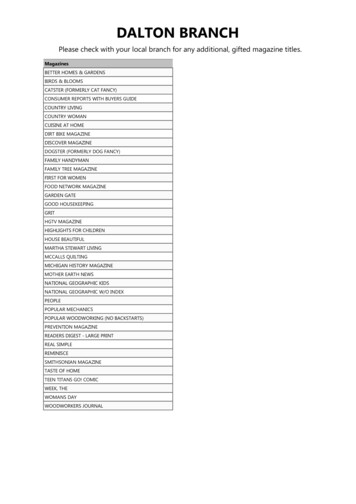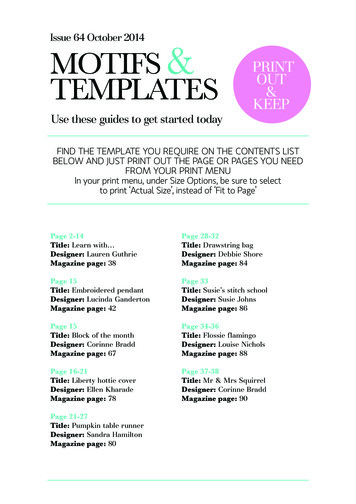
Transcription
INNOVATION IN MAGAZINE MEDIA 2016-2017 WORLD REPORTINNOVATION INMAGAZINE MEDIA2016-2017WORLD REPORTA SURVEY BY INNOVATION MEDIA CONSULTINGFOR FIPP – THE NETWORK FOR GLOBAL MEDIAJUAN SEÑORJOHN WILPERSJUAN ANTONIO GINEREDITORS
32DATAINNOVATION IN MAGAZINE MEDIA 2016-2017,ontentc,eunvewith re er retentionsmelblve pro ucts, subscribosnaproddata cSmart iveness, new ch more.uctad effe isition, and mquand acData is the Swiss Army knife of publishing.One gadget that solves multiple problems.Data can help publishers, editors and addirectors answer, among others, the questions of: How to replace the failing advertising-basedmedia business model How to develop content that leads toincreased audience engagement How to attract, retain, and monetise newreaders/customers
DATAINNOVATION IN MAGAZINE MEDIA 2016-2017All publishers have data. Actually, most publishers have too much data, they just don’tknow what to do with it all.Publishers do not have the tools, talent andprocesses to convert all that data into the invaluable set of insights that data can deliverto increase traffic, conversions, and ad sales,never mind identify new products and servicesthat would have an excellent chance of successbased on readers’ proven behaviours.It’s not like publishers’ data doesn’t see thelight of day. Most media companies have dailyor weekly reports going to editors, sales directors, circulation heads, and website managers detailing basic data like page views anduniques.But from what we’ve seen consulting atmedia companies around the world, mostof the recipients of those data reports don’teven bother to read them. That comes as nosurprise because those reports rarely go beyond the raw numbers to offer analyses andrecommendations for action. The data alsousually comes from only one of many data silos(online, circulation, sales, CRM, etc.), noneof which are connected in a single, universalcorporate database that would enable moreinformed decisions.In a recent study, Forrester found 56% ofUS publishers struggle to get a single view ofmultiple data sources, 59% are frustrated withdisparate platforms, and 54% with disparatemetrics.That’s because, until now, legacy media dataoperations have been a back-office function,more of a report card than a strategic andtactical tool.“Put simply, if the legacy role of a mediacompany was to aggregate an audience and sellit to an advertiser, that's no longer enough,”wrote Folio vice president Tony Silber on thecompany’s blog. “A variety of forces have converged to make that a declining model. If that'sall you're doing as a media company, you'regoing to decline, too.“In the new model, media companies aggregate an audience using content, but then theyuse sophisticated database technology as anengine to learn about audience behaviour,” Silber said. “And they use that acquired knowledge to improve their content, to tailor theircontent for marketing purposes, and to sell33that knowledge to advertisers, helping themcreate marketing products, develop qualifiedleads, and produce ROI.”That’s the great potential of data for publishing companies. It can be an all-purposetool: “The more you know about the consumer,the more effective you can be in marketing tothat consumer — both as a content producerand on behalf of an advertiser. It's just anothercore competency now,” The Enthusiast Network CEO Scott Dickey told Folio.Beyond content and advertising, dataenables publishers to launch new productsand services based on insights into provenconsumer behaviour, offer clients bettermarketing options, and move qualified audiences toward revenue-producing productsand services with greater efficiency and lessaudience fatigue.Cool.But how to begin?“The challenge with building a data-centric business is that for many companies, it'shard to even know where to start,” said Silber. “Executives have to first believe in theeconomic need for the concept and the valuethat it would potentially create.”The first step, then, is psychological andcultural. Everyone, from the top down, hasto accept the need to change. Nothing canhappen without that change in mindset.“What’s been tough is coming to understand that we have to change, that the nextchapter of the company shouldn’t look anything like the last,” Hanley Wood CEO PeterGoldstone told PubExec. “And that means“The challenge withbuilding a data-centricbusiness is that formany companies, it'shard to even knowwhere to start”Tony SilberVice President, Folio
34DATAINNOVATION IN MAGAZINE MEDIA 2016-2017“When you measure attention,you measure quality”Josh SchwartzChartbeat chief data scientistyou've got to make really tough decisions. Weagreed to completely transform the companyinto a digital-first company. I knew a digitalplatform solution based on lead generationand digital engagement with the audiencewas going to be the way.”Goldstone, whose B2B publishing company covers the architecture and constructionsegments, recommends focusing on three keypieces of the puzzle:1. Getting top management aligned2. Breaking down legacy silos, and3. Remaking the corporate cultureAfter that, the hard work begins. “Thenthey must have a vision of how the data initiative would impact existing processes in eachdepartment and across many departments:sales, audience development, marketing, IT,web development, email services, editorial,”said Silber.“And they need to know which softwareproducts are essential to support the effort:A CMS, email programme, awards and eventregistration platforms, and a reporting andanalytic programme,” continued Silber.And they’re still not done: “Finally, theyneed to recruit new skills and teams capableof surfacing, analysing, creating content, andselling based on data analytic,” concludedSilber."If you're a small business, this requirescrawling before walking before running —“Now data acts as the guidinglight for setting mediaand marketing servicessolutions,”and a pretty substantial investment in thelearning curve on how to make use of data,”Moffly Media CEO Jonathan Moffly told Folio.“A chief insights officer may be one of thethree most important people in my companyof the future.”After acquiring that insights officer (whowill bring informed expertise to the next setof corporate decisions), Moffly recommendseliminating all the legacy, stand-alone databases in various departments that do not andcannot talk to one another. He recommendsinstalling a universal database managementsoftware system across all of a company’ssources of data including editorial, fulfilment,events, email, and sales. "We want to understand how many ways we're touching a singleperson, and right now we don't," Moffly said."We have five different groups of activitiesgoing on and nothing that really links them.”With these systems and an insight officein place, a publisher can move to train teammembers on how to use, manipulate, interpret and act on the data. Moffly has createda monthly reporting process and designatedthe chief insights officer to answer questionsand do training.
INNOVATION IN MAGAZINE MEDIA 2016-2017DATA35Data-driven actions to takeBEFORE you publishData can be used twice in the life of a story.An editorial data team can analyse readerpatterns to find topics and related stories thatmight not occur to editors.According to Chris Wiggins, chief datascientist at The New York Times, “Statisticalanalysis leads to a story, and many newsroomsare making a big investment in newsroomanalytics.”So, for editors looking for story topics,research into internal and external contentconsumption trends can be identified. Thereare also APIs on Facebook, Twitter and Googlethat can indicate trending topics and extent ofcoverage.Data can also be used to help editorsdetermine the successful characteristics ofgood headlines, story lengths, etc.Editors can also deliver super-refined contentto readers who have been grouped by ademonstrated interest in a common topic.Once the transformation is complete, everything changes.“Now data acts as the guiding light forsetting media and marketing services solutions,” said Hanley Wood’s Goldstone. “Thathas transformed the company dramatically.Where we used to lead with media or tradeshow sponsorships, now we lead with data.“We hired over 20 people from the techmedia space to help build up all our digitalplatforms and strategic marketing services,”he said.Data now informs everything at HanleyWood, from editorial decisions to long-termconsultative marketing engagements, websitedevelopment, lead generation and contentmarketing. Hanley Wood hasn’t stoppedthere. Goldstone has branched out into providing data-as-a-service, offering databasemanagement services to help clients aligncustomer acquisition, media, marketing, andevents strategies.As a result, Hanley Wood’s customers areData-driven actions to takeAFTER you publishThe most important thing to do after publishinga story is: Optimise how you promote it,according to Ky Harlin, BuzzFeed’s director ofdata science speaking to Contently.“We do this by following methods borrowedfrom biology,” he said. “BuzzFeed is knownas a viral content company, and one of thebasic statistics people look at with viruses isreproduction rate. So for every one personwho has some disease, how many more getit directly as a result? And there are obviouslycorrelations for sharing. For content, we cantell within an hour or so of publishing whattype of stuff we should put prominently on thehome page, promote on Twitter, things likethat. That’s where data science can be reallyuseful.”“enlisting our talent, our expertise, our specialisation, our data services, and our data tohelp build more robust databases that theycan leverage for marketing purposes,” saidGoldstone.The dominance of data has changed thewhole marketing landscape, and is forcingmedia companies to adapt, according to Silber.“A media company with a strong position andthe right skill sets can dominate a marketwith a much broader portfolio of products,all based on data analysis: Lead generation,lead nurturing, branding solutions, strategicinsights, thought leadership, marketing services, research.”As challenging, and perhaps disturbing, asthis might sound, it is actually a good thing:“The good news is that these dynamics havecreated a new media-company sweet spot,”said Silber. “No one else — not Google, notsocial media, and not marketers themselves— possess all the skills needed to maximisemarket engagement and marketing ROI.”
36DATAINNOVATION IN MAGAZINE MEDIA 2016-2017How to measurereader engagementThere are many ideas on what measuresconstitute reader engagement. Here are thetop seven data points for reader engagementfrom AudienceBloom.comConversionsEmailsign-upsTimespent onpageSocialshares4Comments2RepeatvisitorsWho is in charge of data?Bouncerates3“What the data marketers care about isaudience, and audiences only happen becausethey use our media,” Ziff Davis senior vicepresident of data solutions Bennett Zucke toldFolio. “Media is still the core driver of data,but it's just that the data is offering a brandnew revenue opportunity.”By the same token, data also enables aneditorial team to deliver a better and moreuser-centric experience, according to CondéNast vice president of growth and data scienceKy Harlin.7156“Media companies large and small, B2Band consumer, are all moving ahead withdata-driven business models, and not content-and-advertising models,” concludedSilber.The Harvard Business Review Group (HBR)is already there. “We view our subscriber fileas just as crucial to the sustainability andgrowth of the business as our content archive.And the two really do go hand in hand. Wewant to understand what motivates our audiences and what they are looking for, andthe evolution of the audience — from someonewho comes in anonymously to someone whoregisters and then subscribes. We then wantto focus on retention,” HBR Group vice president, marketing Sarah McConville told FIPP.This is a key adjustment in a publishingcompany’s vision of itself: "We are becominga CRM management partner: We’re really aninformation and services company that has amedia companion,” Hanley Wood's Goldstonesaid.Data and editorial: A symbiotic relationshipBeing data-centric does not diminish thepower or importance of editorial content.The sudden urgency of mastering the mountains of data is thrusting an entire new classof people into the world of publishing: statisticians.As publishers scramble to make sense oftheir data, they are stumbling over themselves to hire data scientists to transform allthe raw data into strategic and tactical gold.Mashable went for a Ph.D. in theoreticalcondensed matter physics as their first chiefdata scientist. Haile Owusu’s expertise is inthe parameterisation and exact solution ofintegrable matrices. OK, in English, all hisacademic work involved statistical learningas applied to predictive analytics, hence the anot-so-outlandish jump to media analytics.Maybe there is some publishing magic intheoretical physics because The New YorkTimes also hired a Ph.D. in theoretical physicsas its first chief data scientist in 2014. ChrisWiggins, who was also associate professorof applied mathematics at Columbia University, now leads a small team using machinelearning to monitor reader behaviour andanalyse what keeps readers coming back,and what doesn’t.“Subscribers are telling you what they likeabout the content — you just have to listen,”Wiggins told Digiday.At News Corp., they also went for a Columbia professor, but not in physics. Dr. RachelSchutt, holds a Ph.D. in statistics, and twoMaster’s degrees — one in math from Columbia and one in engineering-economic systems and operations research from Stanford.Not every publishing company sees theneed for a chief data scientist.At news site Vocativ, there is not a single
INNOVATION IN MAGAZINE MEDIA 2016-2017data expert, but half a dozen analysts froma variety of backgrounds, including law enforcement, NGOs, and private equity, who diginto corners of the web where even Googledoesn’t go. They and the four dozen Vocativereporters then use the company's Open Mindproprietary platform to create stories that noone else can see or, hence, publish.“We feel it’s the best way to get stories thatother people don’t have,” Vocativ managingeditor Markham Nolan told Digiday. “Byusing people who understand data, how tomonitor very low-level sources, we can findvery unique pieces of content.“[Of the] last five to ten hires that we’vemade spanning the organisation, almost allof them have some sort of data specialty,”president of Hanley Wood Digital AndrewReid told Publishing Executive. “We havea team of three people whose sole focus istesting our email templates, day in and dayout. Likewise, the last three editorial hireswe’ve made have all been SEO specialists who really understand who’s coming to thesite, how they’re engaging, where the entrypoints are, where the exit points are, what’sworking, and what’s not. That’s driving [engagement] much more than the instinctualapproach that our editors have historicallytaken.”Scripps Networks also did not hire a chiefdata scientist. The best way to get the bestexpertise across so many areas — front-enddevelopment, operations, programminglanguage, analytics — is to have a team ofspecialists, said Scripps Networks Interactivevice president, audience development LauraEvans at the International News Media Association World Congress in New York in 2015.However a publisher approaches thestaffing issue, the data people must not bestereotypes of communication-challengedgeeks, but men and women who can reachout to the data-challenged across the company and get them comfortably involved. Datapersonnel must be good at building bridgesand getting buy-in from colleagues whomight initially be threatened by the wholedata thing, according to Toronto’s Globe andMail vice president of data science and audience intelligence Greg Doufas speaking tothe International News Media AssociationDATA37How to getnon-digital dataThe data from websites alone does not give apublisher the complete story about why peoplelike, love, or hate your content, according toHarvard Business Review group publisherand executive vice president Joshua Macht.Here’s where his team finds other sources ofcustomer insights:Speaking with our customers at live eventsConducting user-tests and focus groupsAnalysing buying patternsSurveying our 10,000 member HBR AdvisoryGroupLaunching lean versions of new products andgetting feedbackPolling our social media communityThe responses from these varioussources are then interwoven with whatwe learn from our data and analytics. Theultimate business objective for us is toreduce the costs of customer acquisitionwhile improving retention rates by creatinga much deeper relationship with ourcustomers. We want customers to havea deep sense that we know what theyneed from HBR. Our belief is that a moreefficient marketing engine allows us toallocate more dollars towards improvingupon the subscription offer, which thenproduces greater engagement and in turnbetter data for us to deepenthe relationship with ourcustomersJoshua MachtHarvard Business Reviewgroup publisherWorld Congress.“Make sure you hire people who knowhow to have a conversation with someone else in their own language,” he said.Make the database easy to use and accessOnce you’ve got your data team together, theyneed to decide about ease of use, access, andworkflow.With a unified database touching just aboutevery department in a publishing company,uncertainty or even hostility can surround
38DATAthe question of access and responsibility(read, ownership). Who should own datainitiatives? Who should have access to data?Who should be held responsible for building,analysing and deploying it?"We all know media companies need tobe able to combine both offline/online datainto one central database," James Capo, vicepresident of digital business developmentat B2B publisher Access Intelligence, toldFolio. "But the key is creating the operationalworkflow around the data. The data meansnothing if the business units can't quicklyaccess it and put it into revenue generatingopportunities or ideas.”“The key is to start with the end user ofdata within the company, the sales or marketing professionals, along with the contentcreators who adjust what they do as audienceengagement data suggests preferences,” saidCapo.And then Capo outlined for Folio his sixrules for database success:1. Ease of use: Any unified database tool needsto be one that is easy to use, one that thebusiness owners want and are willing to use2. Demos and user testing: These are criticalwhen selecting systems. The data conversation, and more importantly, access to thedata, needs to move out of the back office intothe hands of the operating groups3. Instant access by all parties: Sales and mar-INNOVATION IN MAGAZINE MEDIA 2016-2017keting shouldn't have to pick up the phoneand ask someone for data they want to use.They should be able to access it at any timeand create simple target segments in an intuitive platform on their own4. Easy creation of audience segments on thefly: Sales should be able to create audiencesegments, in real time, while sitting with aclient. As they do that, the client will startto ask more engaging questions, and beginto play the "what if" scenario: "What if wechange that, or add this?" It quickly becomesa more consultative conversation5. Segmentation for marketers: Marketersshould be able to create segments that showthem which readers/attendees are most engaged on their site, or with email, as well asadd demographics filters and then be able toquickly deploy a campaign against that data6. Capability to accept “off-line” data: Theplatform should be able to input "offline"data like print subscriptions or registrationdata that may not be as dynamic (in termsof changing often like web behaviours) butprovides valuable first-party infoHow to decide where to get what data?So far, so good. Now, where should publishersgo to get their data?Basically, they should look anywhere consumers interact with the publishing company.”You have to be able to deliver more clear,
INNOVATION IN MAGAZINE MEDIA 2016-2017quantitative, quantifiable insights into theconsumer,” The Enthusiast Network (TEN)CEO Scott Dickey told Folio.So Dickey and TEN have systems, for example, to capture multiple attendee behavioursat live events, plus gathering website analyticsfrom reader behaviour on TEN pages, andthen following those readers when they leaveto go elsewhere. With TEN videos, Dickeyis pushing more content behind a paywallto increase data collection (and, by the way,subscriber revenue)."We're very focused, for example, on whatcontent they're digesting on what car," Dickey said. "What make and what model — andthen sharing that with our OEM [originalequipment manufacturer] partners. We'relooking for consumer data points and traitsthat influence strategies within the channel.”Other publishers capture data via promotions, contests, white paper downloads,forums, etc.But of all the data a publisher can collect, the most important are the indicatorsof engagement. That opinion, however, isnot shared by everyone. There is still somesentiment for clicks, page views and uniquevisitors, and there is still a debate over whatare truly revealing data.“What seem like the simplest, most directmetrics for determining success in the digitalpublishing space — clicks and page views —only tell part of the story,” wrote Chartbeatchief data scientist Josh Schwartz in the company’s 2015 year-end message. “Page viewstell you whether a headline was catchy, notwhether the content was any good. They tellyou if you’ve got a big spike in traffic, but notwhether those visitors are coming back. Yourgoal is not to chase clicks, it’s to grow a loyal,returning audience. That’s where attentioncomes in. When you measure attention, youmeasure quality.”According to the Columbia JournalismReview (CJR), the click is “a poor measureof audience, applying the same value to anattentive reader and a drive-by visitor.”Chartbeat substantiated that opinion inresearch that found 55% of all page views getless than 15 seconds of engagement, according to the company. And when visitors areengaged for 15 seconds or more, viewabilityDATADATA TOOLS: Questionsto ask yourself before youwrite any chequesWhen a publisher decides to dive into data, thegreatest temptation is to just go out and buy allsorts of data tools and software.Slow down.There are some basic questions that should beinvestigated and answered before writing anycheques.Greg Bright, former director of consumerinsights for Gannett and now chief dataofficer at LEAP Media Solutions, offeredthese questions as a good starting point inhis column for the International News MediaAssociation (INMA):“Why? Do I need it now? Can I use it if I haveit? What does it mean to my IT department?To my marketing department? What does itcost? What does it take to use? How muchtraining does it require? How long does it taketo deploy? And, in the end, what will I get, andis there a return?”Bright warned that the analytical tools and thequerying tools are still being developed, so theycan be difficult and expensive to use. Vendorsare entering, leaving, merging, and acquiring,so the landscape is in flux, he said.“The technology does have a place, but youhave to do your research before you get toofar into the discussions and find yourselfcommitted to a path that doesn’t fit yourneeds,” wrote Bright.“Moving to a big data tool set requires a new ITinfrastructure, skills, and analytical packages,”wrote Bright. “Do you really understand whata data scientist is, what one costs, whatthey produce? Can you move the results toproduction fast enough to matter? Does arecommendation need to refresh right away?How much delay is acceptable? Do youunderstand how to analyse around what somerefer to as ‘the curse of big data’? Do youunderstand the costs to push up and pull downthe data?”39
40DATAis 60% compared with just 28% for readerswho spend less than 15 seconds with a story.“Clicks are also easy to fake,” wrote CJRsenior editor Alexis Sobel Fitts on cjr.org. “Atone point, corrupt marketers hired armies ofhumans to increase impressions with theirmouse, but now the process has been outsourced to robots. These “fraudulent bots”are responsible for about 36% of online traffic, according to data cited by the InteractiveAdvertising Bureau.”The problem is that since the beginning ofdigital advertising, cost per thousand impressions (or CPM) has been the industry standard.But clicks can be easily bulked up usingtricks like clickbait headlines that do notmean readers actually spent time on thepage. Some publishers such as Gawker haveexacerbated the problem by paying staff basedon traffic.The advertising industry’s undying attachment to clicks drove the kind of behaviourone would expect: Deliver clicks at all costs.One example illustrates the dilemma. WhenChartbeat founder Chris Haile asked the webeditor of a publishing company about hisreaders’ interests, the editor replied that hedidn’t care “as long as I’m hitting my clicknumbers,” recounted Haile to CJR. “That justdepressed the shit out of me,” Haile said.So Haile vowed to change things. “We’re incrisis because we chose the wrong metrics,”said Haile. “And that has kind of screwedeverything.”Valuing time spent on site, instead of rawclicks, would transform the internet into aplace “where quality makes money and greatdesign is rewarded”, Haile told CJR.Would shifting the metric to time movethe internet and advertisers to better, moreintelligent content? Haile believes that thestories people read are of higher quality thanthose they only click on, an assumption hebacked up with data, according to CJR.Chartbeat researched keywords in 2013 andfound that headlines that received the leastamount of attention per click included typicalclickbait words like “top,” “best,” “biggest,”and “richest”, he told CJR. Words receivingthe most attention included “Syria,” “Egypt,”“Obamacare,” “Trayvon,” “Snowden,” and“D.C. 2013”, he said.INNOVATION IN MAGAZINE MEDIA 2016-2017“Time is finite for each of us,” said Haile,adding that its very scarcity makes a reader’s“gift” of time a valuable measure for publishers and advertisers alike.“Impressions and clicks are faulty metrics.The only metric that matters — what we in thisroom are obsessed with — is attention,” NewYork Times executive vice president of advertising Meredith Kopit Levien told attendeesat Social Media Week last year.If attention is important, engagement is thenext level. Engagement can be measured notonly by time but also by actions, such as socialmedia sharing, commenting, emailing, etc.At Mic, a news site for millennials, theyfocus on three measures: “We track overallsharing, thought-leader engagement on social, and media mentions,” Chris Altchek,Mic CEO, told Digiday. “Putting all three together, we’re able to measure the impact ofan individual story. We also track depth ofengagement on a story-by-story basis whichincludes time spend, scroll depth, and howmany readers subscribed to Mic after readinga story.”So let’s look at how smart data can helpsolve publishing’s problems, starting witheditorial:EDITORIAL: How data can help solve contentand audience engagement challengesFor starters, data scientists are not editors.Data scientists can gather, analyse, andinterpret data, and then make recommendations. But editors must bring their experienceand instincts to bear on choosing strategiesand tactics based on data."A critical skill is for editors to synthesisetheir gut instinct about what makes greatjournalism with the signals that they hearfrom the audiences," New York Times directorof analytics innovation James G. Robinsontold World News Media Congress delegates.Beyond time and engagement, both ofwhich indicate reader interest in the topic,editors should look at what drove readers tothe story (headlines, social promotion, video,email newsletters, distributed content, etc.),and try to draw replicable lessons.There are lots of tools to help editors act onthe lessons of data. Chartbeat’s newest editorial tool — Engaged Headline Testing — is the
DATAINNOVATION IN MAGAZINE MEDIA 2016-2017first multivariate testing tool built specificallyfor media sites, according to the company.It is the first tool that optimises for the behaviour after the click, the company said. Fora headline to win in this test, it must be bothenticing enough to attract traffic, but also,and more importantly, compelling enoughto keep an audience on the page. “Not onlydoes this optimise for audience engagementrather than page loads, it also enables editorial teams to directly affect the overall adviewability performance of their site withwinning headlines garnering more time onthe page,” said Haile.And, when quality editorial wins, advertising wins. “In fact, we’ve found that by optimising for clicks that result in more engagedtime on a page — or ‘Quality Clicks’, as wecall them — it means more ads are seen forlonger,” said Haile.Mashable has a proprietary predictive analytics tool, Velocity, which monitors howstories are shared and interacted with acrosssocial networks. Because it can predict withan impressive degree of certainty which stories will be popular on social media, Mashableeditors “like to think of it as a digital crystalball,” Mashable’s global news editor LouiseRoug wrote on journalism.co.uk.At Ozy Media, “our most important metricis the number of people who are coming tothe site by habit,” Aneesh Raman, Ozy vicepresident of marketing and audience development, told Digiday. “It’s important to us tohave people who know what Ozy is but alsoknow what it’s all about. Our core metric isrepeat visits”.Refinery29, a digital-only site focusedon millennial women, has used reader behavioural data to influence content decisionsand social media promotion. The result hasbeen a 163% annual growth in unique vi
platforms and strategic marketing services," he said. Data now informs everything at Hanley Wood, from editorial decisions to long-term consultative marketing engagements, website development, lead generation and content marketing. Hanley Wood hasn't stopped there. Goldstone has branched out into pro-viding data-as-a-service, offering database











